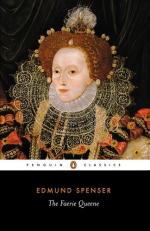32. This description of the dragon watching the tower from the sunny hillside is justly admired for its picturesqueness, power, and suggestiveness. The language is extremely simple, but the effect is awe-inspiring. It has been compared with Turner’s great painting of the Dragon of the Hesperides.
42. O THOU SACRED MUSE, Clio, the Muse of History, whom Spenser calls the daughter of Phoebus (Apollo) and Mnemosyne (Memory).
56. TILL I OF WARRES, etc. Spenser is here supposed to refer to his plan to continue the Faerie Queene and treat of the wars of the English with Philip II ("Paynim King”) and the Spanish ("Sarazin").
61. LET DOWNE THAT HAUGHTIE STRING, etc., cease that high-pitched strain and sing a second (or tenor) to my (lower) tune.
120. AS TWO BROAD BEACONS. Kitchin thinks this passage is a reminiscence of the beacon-fires of July 29, 1588, which signaled the arrival of the Armada off the Cornish coast.
158. HER FLITTING PARTS, her shifting parts; referring to the instability of the air.
161. LOW STOUPING, swooping low (to the ground); a term in falconry.
167. HAGARD HAUKE, a wild, untamed falcon.
168. ABOVE HIS HABLE MIGHT, beyond the strength of which he is capable.
172. HE SO DISSEIZED, etc., i.e. the dragon being thus dispossessed of his rough grip. The construction is nominative absolute.
185. AND GREEDY GULFE DOES GAPE, etc., i.e. the greedy waters gape as if they would devour the land.
187. THE BLUSTRING BRETHREN, the winds.
228. HIS WIDE DEVOURING OVEN, the furnace of his maw, or belly.
235. THAT GREAT CHAMPION, Hercules. The charmed garment steeped in the blood of the Centaur Nessus, whom Hercules had slain, was given him by his wife Dejanira in order to win back his love. Instead of acting as a philter, the poison-robe burned the flesh from his body. Ovid’s Metamorphoses, ix, 105.
xxviii. Observe the correspondence between the adjectives in l. 244 and the nouns in l. 245. The sense is: “He was so faint,” etc.
261. THE WELL OF LIFE. This incident is borrowed from Bevis of Hampton. The allegory is based on John, iv, 14, and Revelation, xxii, 1.
267. SILO, the healing Pool of Siloam, John, ix, 7. Jordan, by bathing in which Naaman was healed of leprosy, II Kings, v, 10.
268. BATH, in Somersetshire, a town famous from the earliest times for its medicinal baths. SPAU, a town in Belgium noted for its healthful waters, now a generic name for German watering-places.
269. CEPHISE, the river Cephissus in Boeotia whose waters possessed the power of bleaching the fleece of sheep. Cf. Isaiah, i, 18. HEBRUS, a river in Thrace, here mentioned because it awaked to music the head and lyre of the dead Orpheus, as he floated down its stream. Ovid’s Metamorphoses, xi, 50.




